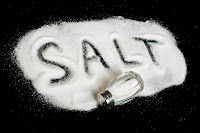Prime Rib Reconstructed? (Meat-Glue 2014)
(Op- 2014) Prime Rib Reconstructed? What is it? Well, first off, it's not "Prime Rib." Prime Rib, as most Americans refer to it, is something of a misnomer.
Prime-Rib (the misnomer) has more to do with the USDA grading system than the actual cut. Beef graded (Crowned) Prime comes from steers with abundant marbling.
Would it surprise you to learn that less than two percent of all U.S. Beef makes the grade of Prime?
The actual cut is a Standing Rib Roast, and the grade is more likely to be in the choice category. Prime meat will cost you between a 100%-150% more per pound. Why do we call it Prime Rib? Because it comes from a section called the rib primal, and from my understanding, it was called this before the USDA grading system.
The USDA grading system is very interesting. There are Prime, choice, and select within the USDA grading system. Within those categories, there are sub-categories too. The "Choice" tier has 3 sub-levels, so buyer beware. Unfortunately, the consumer will never know what they're getting. That meat you're buying could be a 1,2, or 3, and one would never know.

For Black Angus beef to be certified as Black Angus, it has to rate a 1 or 2. Well, that's good news to me because I mostly eat Blank Angus. Take a look at this picture; what do you see? I see tasty meat.
Ok, so what is a reconstructed Prime Rib? So glad you asked. First, let me give credit where credit is due!!! This game-changing technique came from the Chefsteps.com Website. Chefstep's intuitive website helps foodies and hobbyists like myself become better cooks....so Thank You, chefsteps. I also want to thank SeriousEats.com and Amazingribs.com for helping me better understand Prime-Rib!!! A special thanks to my friend Chef Norm over on Facebook who was kind enough to give further insight.
Reconstructed Prime Rib (really a Rib Roast) is a technique in which you removed all the undesired parts of the Rib Roast and put it back together using Transglutaminase. It creates, in my opinion, a perfect Roast. The technique is straightforward, and the meat is opened up very carefully with meticulous precision using a very sharp knife. The goal is to remove all the connective tissue, bones, and undesirables, namely that thick fat that no one wants to eat. After you have done this, put it back together.

Profile pictures of the Rib Roast.


Side profile showing bone removal and some excess fat.

Rib Roast all broken down and undesirables removed.
The Rib Roast was reconstructed using Transglutaminase. Note 1: It takes 24 hours for the Transglutaminase to bind proteins.
Note 2: I lightly salted the meat using a dry brine technique to ensure juiciness for 24 hours. Note 3: This is where the shaping of the Rib Roast takes place. Starting out with a huge and long piece of food-grade plastic wrap (I use a 24-inch wide version), I start rolling the Roast very tight, utilizing a lot of pressure. I want to form a perfect cylinder. After several layers of plastic wrap coats the meat, I sprinkled chopped-up herbs and peppercorns on the plastic wrap. I used thyme, parsley, a little rosemary, and black peppercorns, but you can use whatever you like. As I am rolling the Roast up, I am piercing the plastic wrap with a toothpick (or sausage pricker) to allow air to escape, allowing for a tighter roll.

After the Roast is shaped into a perfect cylinder and is nice and tight, I tie it off with a string. Again I pierce the plastic wrap with a toothpick or whatever you have. The piercing serves two purposes. It allows for a tighter cylinder, and as the protein cooks, the herbs perfume the meat with Herby flavors (yes, that is a made-up name). I know what you're thinking...How about rolling up the herbs on the outside of the meat? This is also a NO NO because the spices would overpower the meat. My indirect approach will allow for subtle fragrances to permeate the protein. Please refer to the above links for additional instructions.

Vacuumed, Sealed, and ready for SV. So the plan is to SV this hunk of meat for 24 hours at 128 degrees.
Meat is all done. Very unattractive. No to fear; I need to blast it with intense heat. The lacking of Browning (Maillard) is one of the shortcomings of SV. You need to brown it with a torch like my SearZALL or blast it with another heat source like your oven or BBQ. I also made roasted garlic, herb, peppercorn paste, and coasted meat before blasting it with my Searzall.
ALL DONE!!!
Overall it came out great, but there's a need for improvement. 24 hours was too long, and 15-18 hours would have been adequate. I wanted more roast taste, so maybe an hour or two in my smoker will help next time. Maybe blast it with my Charcoal Weber for the Maillard reaction I needed.
Now for the gratuitous pictures.












Comments
Post a Comment